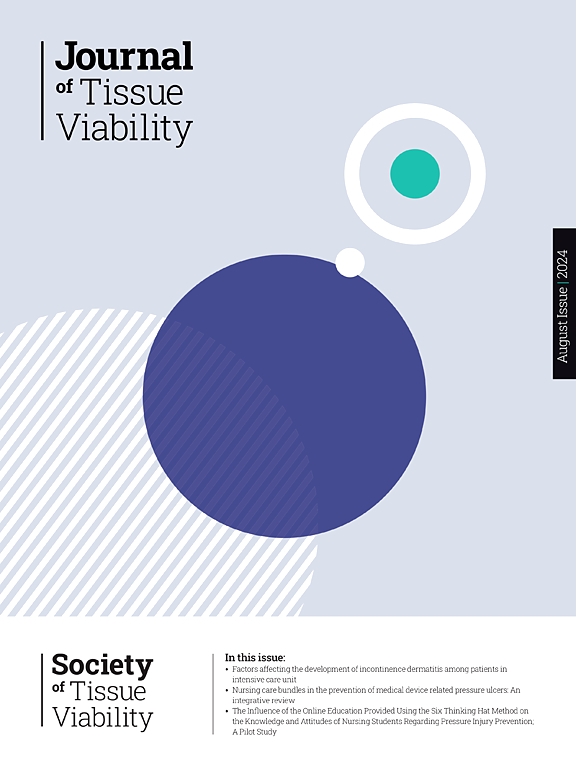A health economic analysis of ‘A novel implementation of best evidence practice for incontinence-associated dermatitis’ (IMBED)
IF 2.4
3区 医学
Q2 DERMATOLOGY
引用次数: 0
Abstract
Aim
To assess resource usage and other outcomes of implementing a bundle of evidence-based, clinician-led incontinence-associated dermatitis interventions, ‘IMBED’ intervention.
Methods
Patients with incontinence recruited from 6 public hospitals in Australia in pre-intervention (1 February-31 March 2020) and post-intervention periods (1 May-30 June 2021). For the health economic study, nurses/research officers recorded resource usage for a random sample of incontinence care episodes each week.
Results
799 patients with incontinence (9645 incontinence care episodes). There were significant differences in the proportion of incontinence care episodes using specific product-types between the pre- and post-intervention groups, with the greatest increase for treatment/prevention products (55.2 % versus 82.8 %; p < 0.001) and decrease for underpads/bed pads (28.5 % versus 12.9 %; p < 0.001). There was a significant decrease in mean total product cost per incontinence care episode between these groups (AU$2.64 versus AU$2.35; p < 0.001). There was a significant increase in mean staff cost per incontinence care episode between these groups (AU$9.65 versus AU$10.09; p = 0.001), driven by increases in the mean number of staff and time spent per episode. There was an increase in mean total cost per incontinence care episode (AU$0.15) between these groups but not significant (p = 0.344).
Conclusion
There was a significant decrease in mean total product cost per incontinence care episode in the intervention group. There was no significant change in mean total incontinence care cost per episode associated with the intervention, suggesting hospitals adopted IMBED with minimal extra expenses. There was streamlined resource usage and reductions in products not supported by evidence-based guidelines.
“失禁相关性皮炎最佳证据实践的新实施”(IMBED)的卫生经济学分析
目的评估实施一系列循证临床主导的尿失禁相关性皮炎干预措施(“IMBED”干预)的资源使用情况和其他结果。方法在干预前(2020年2月1日至3月31日)和干预后(2021年5月1日至6月30日)从澳大利亚6家公立医院招募尿失禁患者。在卫生经济研究中,护士/研究人员每周随机记录尿失禁护理事件的资源使用情况。结果799例尿失禁患者(尿失禁护理发作9645次)。在干预前和干预后两组中,使用特定产品类型的尿失禁护理事件的比例存在显著差异,治疗/预防产品的增幅最大(55.2%对82.8%;p & lt;0.001),护垫/床垫减少(28.5%对12.9%;p & lt;0.001)。两组患者每次尿失禁护理的平均总产品成本显著降低(2.64澳元对2.35澳元;p & lt;0.001)。在这些组之间,每次尿失禁护理的平均员工成本显著增加(9.65澳元对10.09澳元;P = 0.001),这是由于平均工作人员数量和每集花费的时间增加所致。这些组之间每次尿失禁护理的平均总费用(0.15澳元)有所增加,但不显著(p = 0.344)。结论干预组每次尿失禁护理的平均总产品成本显著降低。与干预相关的每次发作的平均尿失禁总护理费用没有显著变化,表明医院采用IMBED的额外费用最小。精简了资源使用并减少了未得到循证指南支持的产品。
本文章由计算机程序翻译,如有差异,请以英文原文为准。
求助全文
约1分钟内获得全文
求助全文
来源期刊

Journal of tissue viability
DERMATOLOGY-NURSING
CiteScore
3.80
自引率
16.00%
发文量
110
审稿时长
>12 weeks
期刊介绍:
The Journal of Tissue Viability is the official publication of the Tissue Viability Society and is a quarterly journal concerned with all aspects of the occurrence and treatment of wounds, ulcers and pressure sores including patient care, pain, nutrition, wound healing, research, prevention, mobility, social problems and management.
The Journal particularly encourages papers covering skin and skin wounds but will consider articles that discuss injury in any tissue. Articles that stress the multi-professional nature of tissue viability are especially welcome. We seek to encourage new authors as well as well-established contributors to the field - one aim of the journal is to enable all participants in tissue viability to share information with colleagues.
 求助内容:
求助内容: 应助结果提醒方式:
应助结果提醒方式:


